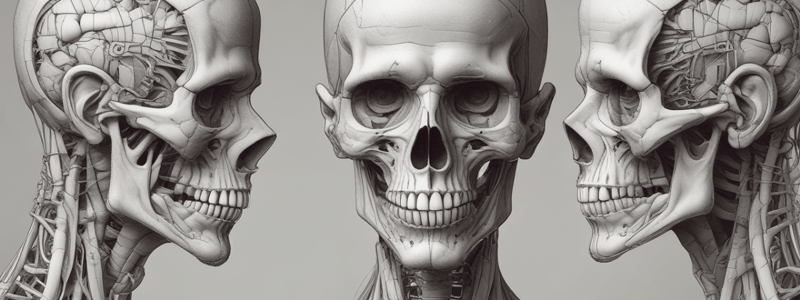Podcast
Questions and Answers
What is the role of the fixator in a muscle action?
What is the role of the fixator in a muscle action?
- To move the bone
- To stabilize the bone (correct)
- To initiate the movement
- To control the movement
What type of muscle is responsible for moving the bone?
What type of muscle is responsible for moving the bone?
- Prime mover (correct)
- Antagonist
- Synergist
- Fixator
Which of the following muscles helps to enhance the movement of the prime mover?
Which of the following muscles helps to enhance the movement of the prime mover?
- Antagonist
- Agonist
- Synergist (correct)
- Fixator
What is the name of the blood vessels that transport blood back to the heart?
What is the name of the blood vessels that transport blood back to the heart?
What is the purpose of the valves in the blood vessels?
What is the purpose of the valves in the blood vessels?
In the anatomical position, what is the direction of the face?
In the anatomical position, what is the direction of the face?
In what position are the upper limbs in the anatomical position?
In what position are the upper limbs in the anatomical position?
What is the direction of the palms of the hands in the anatomical position?
What is the direction of the palms of the hands in the anatomical position?
What is the assumption about the person's posture in the anatomical position?
What is the assumption about the person's posture in the anatomical position?
What is the primary purpose of the anatomical position?
What is the primary purpose of the anatomical position?
How many pairs of cranial nerves exist in the human body?
How many pairs of cranial nerves exist in the human body?
Which of the following bones is NOT part of the facial skeleton?
Which of the following bones is NOT part of the facial skeleton?
What is the function of the pharyngeal tubercle?
What is the function of the pharyngeal tubercle?
Which bone is involved in the formation of the orbit?
Which bone is involved in the formation of the orbit?
How many bones are involved in the formation of the facial skeleton?
How many bones are involved in the formation of the facial skeleton?
What is the name of the country represented by the emblem?
What is the name of the country represented by the emblem?
Which of the following is NOT a department of the government?
Which of the following is NOT a department of the government?
What is the translation of 'ال επισ العل والبحث'?
What is the translation of 'ال επισ العل والبحث'?
What is the name of the university mentioned in the emblem?
What is the name of the university mentioned in the emblem?
What is the superior orbital fissure related to?
What is the superior orbital fissure related to?
What is the question asking about the superior orbital fissure?
What is the question asking about the superior orbital fissure?
What is the number of the topic about the types of processes of neurons?
What is the number of the topic about the types of processes of neurons?
What is the topic mentioned after the topic about the types of processes of neurons?
What is the topic mentioned after the topic about the types of processes of neurons?
What is the topic mentioned after the topic about the parts of the skin?
What is the topic mentioned after the topic about the parts of the skin?
How many topics are mentioned in the given content?
How many topics are mentioned in the given content?
What is the last topic mentioned in the given content?
What is the last topic mentioned in the given content?
What is the topic that is not related to the human body?
What is the topic that is not related to the human body?
What is the position of the topic about the types of muscle in the given content?
What is the position of the topic about the types of muscle in the given content?
What is the number of the page where the content is written?
What is the number of the page where the content is written?
Flashcards are hidden until you start studying
Study Notes
Anatomy Questions
- The superior orbital fissure is a passage for certain nerves, but not the pharyngeal nerve.
- There are 12 pairs of cranial nerves.
- The facial skeleton consists of bones, except for the sphenoid.
Muscle Types
- There are different types of muscles.
Blood Vessels
- Blood vessels that transport blood back to the heart are called, and many of them possess valves.
Anatomical Position
- The anatomical position is described as a person standing erect, with upper limbs by their sides and the face and palms of the hands directed.
Neurons
- Neurons have different types of processes.
Skin and Mandible Bone
- The skin has different parts.
- The mandible bone has different parts.
General
- Good luck is wished to the student.
Studying That Suits You
Use AI to generate personalized quizzes and flashcards to suit your learning preferences.




